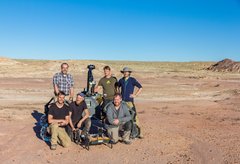In FT-Utah, DFKI researches along with scientists of the University of Bremen the use of robots in the exploration of alien planets. Part of the project was the four-week field test campaign in the desert of the American State, in which the systems should be tested outside the laboratory in a natural, unstructured environment and simulate a complete mission sequence together with a control station in Bremen. Six DFKI scientists traveled to the isolated area near Hanksville, where they set up the base station for the field tests. The robots, as well as the necessary equipment, had already started their journey a few weeks before, safely stowed in a ship container.
An unequal robot team faced the challenge
Among the systems tested in Utah were the hybrid walking and driving rover SherpaTT and the micro rover Coyote III, both developed and build as part of the TransTerrA project at the Robotics Innovation Center. The 150 kg heavy SherpaTT, which is – thanks to its active suspension system – particularly well-suited for rough terrain, has six standardized electromechanical interfaces that serve, among other things, for the transport of larger payload units. In addition, the rover is equipped with an about two-meter-long centrally mounted robot arm – a so-called manipulator – with six degrees of freedom, which allows him for example to collect soil samples and deliver them to the smaller rover Coyote III, which is significantly lighter with 15 kg. By the use of star-shaped wheels in combination with a passive suspension system the micro rover also achieves high mobility in unstructured terrain, especially on steep slopes. Via two interfaces it can be extended with payload containers as well as a robot arm. In this way, Coyote III can also carry payloads, that is why it serves as a support system for SherpaTT during the field tests.
The robot team was completed by immobile robotic units, namely a BaseCamp as well as various payload containers equipped with electromechanical interfaces. The BaseCamp was used as a communication station for transferring data and as a modular junction for the reception of payload containers – it was transported and set up by SherpaTT via an interface. In FT-Utah, the payload containers were primarily used for sampling. The standardized boxes can also be equipped with different types of sensors, battery packs or instruments.
Mission control from Bremen – 8,300 km away
A control station was set up at the Robotics Innovation Center in Bremen to allow the control of the intended mission, which built a communication link to the robots in Utah via satellite. The Virtual Reality Lab, an interactive 3D multi-projection facility, enabled the operator to observe the mission status in a virtual reality. In addition to a pointing device, a two-armed upper body exoskeleton served as an input and control device. This allowed the operator to control the robots in Utah intuitively with natural movement patterns. Through integrated force feedback, he also received direct feedback on the SherpaTT's manipulator, enabling him to safely move and place it in the more than 8,300 kilometers away.
In addition to the control station in Bremen, the scientists set up a mobile control center on the test ground in Utah. This not only enabled the test and the execution of mission sequences on the spot, but also served to transmit the data received by the robots via satellite to Bremen.
Successful simulation of a sample return mission
In the field trials in Utah, parts of a Mars sample return mission were successfully simulated. The individual mission steps were controlled from the control station in Bremen: the operator initially requested three-dimensional environmental maps from the systems as well as photos from the robot cameras in order to get a picture of the surroundings. He then put waypoints into the cards, which were approached autonomously by the two rovers. At the point of sampling, the manipulator of SherpaTT was managed manually using the exoskeleton. After a rendezvous of the two robots, Coyote III finally navigated back to the starting point along the set waypoints independently.
The implementation of the autonomous behavior of the robots was a great challenge within the field test campaign, since not only a single system, but a robot team with different sensors was used. The team had to move safely in a completely unknown terrain – aside from very rough overview maps. Therefore the DFKI scientists used special self-localization and mapping algorithms, which integrated the information from the different sensors and generated a corresponding map.
System tests provide important data for the further development of the robots
In addition to the cooperative mission, the systems were individually tested for their mobility in unstructured terrain. SherpaTT successfully overcomes slopes of up to 28 degrees – its active ground adjustment ensured the permanent ground contact of all four wheels with approximately the same load distribution. Coyote III coped with gradients of up to 42 degrees and even drove steep cliffs with overhangs using a rope system. Overall, the DFKI scientists have gained important insights into the robustness and mobility of their systems, as well as for the autonomous and cooperative exploration of unstructured environments through the field test campaign. Through the use of the Virtual Reality Lab they have also succeeded in demonstrating an intuitive mission control under realistic conditions.
Scientists from the DFKI Robotics Innovation Center and the University of Bremen are involved in the project FT-Utah from Department 3, Robotics, under the direction of Prof. Dr. Frank Kirchner. FT-Utah and TransTerrA are funded by the Space Agency of the German Aerospace Center (DLR) with funds from the Federal Ministry of Economics and Energy (BMWi).
More information:
dfki.de/robotics/research/projects/ft-utah.html
twitter.com/ft_utah
Project Video:
www.youtube.com/watch
Contact:
German Research Center for Artificial Intelligence (DFKI GmbH)
Robotics Innovation Center
Prof. Dr. Frank Kirchner
Mail: Frank.Kirchner[at]dfki.de
Phone: +49 421 178 45 4100
Press contact:
German Research Center for Artificial Intelligence (DFKI GmbH)
Corporate communications Bremen
Mail: uk-hb[at]dfki.de
Phone: +49 421 178 45 4180


